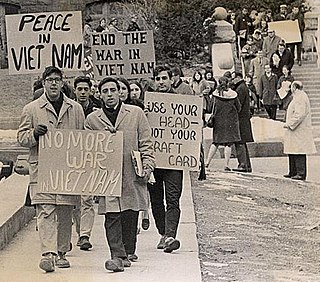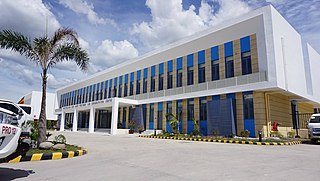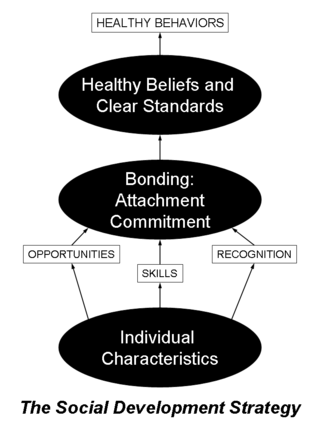
Youth culture refers to the societal norms of children, adolescents, and young adults. Specifically, it comprises the processes and symbolic systems that are shared by the youth and are distinct from those of adults in the community.

Juvenile delinquency, also known as juvenile offending, is the act of participating in unlawful behavior as a minor or individual younger than the statutory age of majority. These acts would otherwise be considered crimes if the individuals committing them were older. The term delinquent usually refers to juvenile delinquency, and is also generalised to refer to a young person who behaves an unacceptable way.
Youth mentoring is the process of matching mentors with young people who need or want a caring, responsible adult in their lives. Adult mentors are usually unrelated to the child or teen and work as volunteers through a community-, school-, or church-based social service program. The goal of youth mentoring programs is to improve the well-being of the child by providing a role model that can support the child academically, socially and/or personally. This goal can be accomplished through school work, communication, and/or activities. Goals and settings within a mentoring program vary by country because of cultural values.

The American juvenile justice system is the primary system used to handle minors who are convicted of criminal offenses. The system is composed of a federal and many separate state, territorial, and local jurisdictions, with states and the federal government sharing sovereign police power under the common authority of the United States Constitution. The juvenile justice system intervenes in delinquent behavior through police, court, and correctional involvement, with the goal of rehabilitation. Youth and their guardians can face a variety of consequences including probation, community service, youth court, youth incarceration and alternative schooling. The juvenile justice system, similar to the adult system, operates from a belief that intervening early in delinquent behavior will deter adolescents from engaging in criminal behavior as adults.
Paul B. Baltes was a German psychologist whose broad scientific agenda was devoted to establishing and promoting the life-span orientation of human development. He was also a theorist in the field of the psychology of aging. He has been described by American Psychologist as one of the most influential developmental psychologists.
Emotional and behavioral disorders refer to a disability classification used in educational settings that allows educational institutions to provide special education and related services to students who have displayed poor social and/or academic progress.
An at-risk student is a term used in the United States to describe a student who requires temporary or ongoing intervention in order to succeed academically. At risk students, sometimes referred to as at-risk youth or at-promise youth, are also adolescents who are less likely to transition successfully into adulthood and achieve economic self-sufficiency. Characteristics of at-risk students include emotional or behavioral problems, truancy, low academic performance, showing a lack of interest for academics, and expressing a disconnection from the school environment. A school's effort to at-risk students is essential. For example, a study showed that 80% to 87% of variables that led to a school's retention are predictable with linear modeling. In January 2020, Governor Newsom of California changed all references to "at-risk" to "at-promise" in the California Penal Codes.

A residential treatment center (RTC), sometimes called a rehab, is a live-in health care facility providing therapy for substance use disorders, mental illness, or other behavioral problems. Residential treatment may be considered the "last-ditch" approach to treating abnormal psychology or psychopathology.
After-school activities, also known as after-school programs or after-school care, started in the early 1900s mainly just as supervision of students after the final school bell. Today, after-school programs do much more. There is a focus on helping students with school work but can be beneficial to students in other ways. An after-school program, today, will not limit its focus on academics but with a holistic sense of helping the student population. An after-school activity is any organized program that youth or adult learner voluntary can participate in outside of the traditional school day. Some programs are run by a primary or secondary school, while others are run by externally funded non-profit or commercial organizations. After-school youth programs can occur inside a school building or elsewhere in the community, for instance at a community center, church, library, or park. After-school activities are a cornerstone of concerted cultivation, which is a style of parenting that emphasizes children gaining leadership experience and social skills through participating in organized activities. Such children are believed by proponents to be more successful in later life, while others consider too many activities to indicate overparenting. While some research has shown that structured after-school programs can lead to better test scores, improved homework completion, and higher grades, further research has questioned the effectiveness of after-school programs at improving youth outcomes such as externalizing behavior and school attendance. Additionally, certain activities or programs have made strides in closing the achievement gap, or the gap in academic performance between white students and students of color as measured by standardized tests. Though the existence of after-school activities is relatively universal, different countries implement after-school activities differently, causing after-school activities to vary on a global scale.
Youth engagement is the sentiment young people feel towards a particular person, activity, place or outcome. It has been a focus of youth development, public policy and social change movements for at least forty years. According to a Cornell University program, "Youth engagement is one of the buzzwords in the youth development field. Similar terms are youth voice, youth involvement, youth participation, and youth in governance."
Youth suicide is when a young person, generally categorized as someone below the legal age of majority, deliberately ends their own life. Rates of youth suicide and attempted youth suicide in Western societies and other countries are high. Youth suicide attempts are more common among girls, but adolescent males are the ones who usually carry out suicide. Suicide rates in youths have nearly tripled between the 1960s and 1980s. For example, in Australia suicide is second only to motor vehicle accidents as its leading cause of death for people aged 15 to 25.

Communities That Care (CTC) is a program of the Center for Substance Abuse Prevention (CSAP) in the office of the United States Government's Substance Abuse and Mental Health Services Administration (SAMHSA). CTC is a coalition-based prevention operating system that uses a public health approach to prevent youth problem behaviors such as violence, delinquency, school drop out and substance abuse. Using strategic consultation, training, and research-based tools, CTC is designed to help community stakeholders and decision makers understand and apply information about risk and protective factors, and programs that are proven to make a difference in promoting healthy youth development, in order to most effectively address the specific issues facing their community's youth.
Life skills are abilities for adaptive and positive behavior that enable humans to deal effectively with the demands and challenges of life. This concept is also termed as psychosocial competency. The subject varies greatly depending on social norms and community expectations but skills that function for well-being and aid individuals to develop into active and productive members of their communities are considered as life skills.
Multisystemic therapy (MST) is an intense, family-focused and community-based treatment program for juveniles with serious criminal offenses who are possibly abusing substances. It is also a therapy strategy to teach their families how to foster their success in recovery.
Bullying is abusive social interaction between peers and can include aggression, harassment, and violence. Bullying is typically repetitive and enacted by those who are in a position of power over the victim. A growing body of research illustrates a significant relationship between bullying and emotional intelligence.
Positive behavior interventions and supports (PBIS) is a set of ideas and tools used in schools to improve students' behavior. PBIS uses evidence and data-based programs, practices, and strategies to frame behavioral improvement relating to student growth in academic performance, safety, behavior, and establishing and maintaining positive school culture. PBIS tries to address the behavioral needs of at-risk students and the multi-leveled needs of all students, in an effort to create an environment that promotes effective teaching and learning in schools. Educational researchers such as Robert H. Horner believe that PBIS enhances the school staff's time for delivering effective instructions and lessons to all students.
Robert L. Selman is an American-born educational psychologist and perspective-taking theorist who specializes in adolescent social development. He is currently a professor of Education and Human Development at the Harvard Graduate School of Education, and a professor of psychology in Medicine at Harvard University. He is also known as the author of the 1980s G.I. Joe public service announcements.
School-based prevention programs are initiatives implemented into school settings that aim to increase children's academic success and reduce high-risk problem behaviors.
J. David Hawkins is an American sociologist, academic, and author. He is Emeritus Endowed Professor of Prevention and founding director of the Social Development Research Group in the School of Social Work at the University of Washington. His research focuses on the prevention of behavior problems in children and adolescents. He developed the Communities That Care prevention system with Richard F. Catalano.
Community crime prevention relates to interventions designed to bring reform to the social conditions that influence, and encourage, offending in residential communities. Community crime prevention has a focus on both the social and local institutions found within communities which can influence crime rates, specifically juvenile delinquency.





